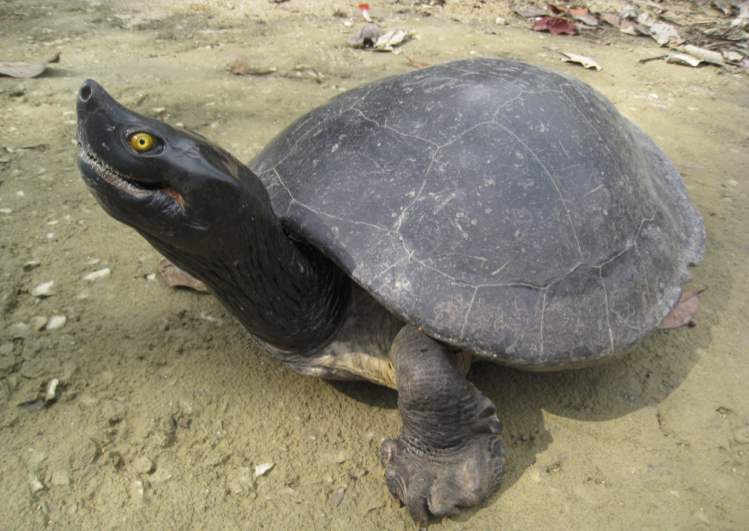Batagur affinis, 090
Batagur affinis (Cantor 1847) –
Southern River Terrapin, Tuntong
Edward O. Moll1, Steven G. Platt2, Eng Heng Chan3, Brian D. Horne2,
Kalyar Platt4, Peter Praschag5, Pelf Nyok Chen3,
and Peter Paul van Dijk6
11941 W Sunset Knoll Lane, Tucson, Arizona 85704 USA [[email protected]];
2Wildlife Conservation Society, 2300 Southern Boulevard, Bronx, New York 10460 USA
[[email protected]; [email protected]];
3Turtle Conservation Society of Malaysia, 56-2/1, Pangsapuri Cerong Lanjut, Jalan Cerong Lanjut, 20300, Kuala Terengganu, Malaysia [[email protected]; [email protected]];
4Turtle Survival Alliance-Myanmar Program, Aye Yeik Mon 1st Street, Yangon, Myanmar [[email protected]];
5Turtle Island, Puntigamerstrasse 7, 8041 Graz, Austria [[email protected]];
6IUCN SSC Tortoise and Freshwater Turtle Specialist Group,
c/o Global Wildlife Conservation, Austin, Texas 78767 USA [[email protected]]
Summary. – The Southern River Terrapin, Batagur affinis (Family Geoemydidae), is a large (carapace length to 625 mm) Critically Endangered river turtle inhabiting large rivers and estuaries of the southern Malay Peninsula (southern Thailand and West Malaysia), Sumatra, and a remnant population in Cambodia. Wild terrapins are omnivorous, but the bulk of the diet consists of vegetation and fruit. Batagur affinis does not feed in salinities exceeding 20 ppt as it has limited physiological adaptability to high saline concentrations. Nesting occurs during the dry season (November through March) when sand banks are exposed by falling river levels. Females move extensive distances up river to nest on riverine sandbanks. Conspicuous differences occur in the nesting behavior of populations in rivers on the eastern and western coasts of Malaysia. West coast populations tend to nest en masse, digging nests at the bottom of deep body pits and then constructing false body pits to confuse predators. Females of east coast populations nest solitarily and may divide the clutch presumably among multiple nests. Multiple clutches can be laid in a single season. In west coast rivers, young emerge from nests after an average of 88 days and emigrate directly downstream to tidal areas. The species, abundant throughout its range in the 19th and early 20th centuries, is severely depleted and Critically Endangered. A small recently discovered population in Cambodia survives on the Sre Ambel River System and produces about 3 nests/year. The species is considered extinct in the wild in Thailand, Vietnam, and Singapore. In Malaysia, only scattered nesting now occurs on the sand banks of west coast rivers where thousands formerly nested. Populations in east coast rivers are faring better and a recent increase in nesting has been reported for the Terengganu River. A newly discovered population on the Kemaman River produced 36 to 121 nests per year between 2012 and 2014. Surveys of Sumatra in the early 1990s found the species to be rare, but no recent information is available. The terrapin’s decline has resulted from extensive exploitation of its flesh and eggs, exacerbated by indirect factors, including habitat alteration and destruction (e.g., deforestation, tin and sand-mining, dam building, erosion control, and pollution) that have damaged the turtle’s nesting areas and feeding habitat. Malaysia has been a leader in conservation action for the species, establishing the first hatchery on the Perak River in 1967. This program has since expanded to include head-starting and captive breeding. Conservation programs now exist in Kedah, Perak, and Terengganu. These efforts have failed to stem the decline on the Kedah and Perak Rivers, but populations on the Terengganu River are now increasing. A population was discovered along the Kemaman River in 2010 and a conservation program was initiated in 2011. In 1987, Thailand established an ex-situ conservation program for the terrapin on the Klong La-ngu River in Satun Province. Thousands of young are being kept and raised, but to date none have been released. In 2001 in Cambodia the Sre Ambel Fisheries Administration began a small conservation program in Koh Kong Province, protecting habitat, nesting areas, and locating nests for a small hatchery program.
Distribution. – Cambodia, Indonesia (Sumatra), Malaysia (West), Singapore (extirpated, reintroduced), Thailand, Vietnam (extirpated).
Synonymy. – Tetraonyx affinis Cantor 1847, Batagur affinis, Kachuga affinis, Batagur affinis affinis, Batagur siebenrocki † Jaekel 1911.
Subspecies. – Two subspecies are currently recognized: 1) Batagur affinis affinis (Western Malay River Terrapin) (distribution: western coast of West Malaysia, adjacent southernmost Thailand, Sumatra); and 2) Batagur affinis edwardmolli (Eastern Malay River Terrapin) (synonymy: Batagur affinis edwardmolli Praschag, Holloway, Georges, Päckert, Hundsdörfer, and Fritz 2009) (distribution: eastern coast of West Malaysia, adjacent southernmost Thailand [extirpated], Cambodia, Vietnam [extirpated]).
Status. – IUCN 2015 Red List: Not Evaluated (B. baska, including B. affinis populations, assessed as Critically Endangered in 2000); TFTSG Draft Red List: Critically Endangered (CR, assessed 2011); CITES: Appendix I; USA Endangered Species Act: Endangered.
Citation:
Moll, E.O., Platt, S.G., Chan, E.H., Horne, B.D., Platt, K., Praschag, P., Chen, P.N., and van Dijk, P.P. 2015. Batagur affinis (Cantor 1847) – Southern River Terrapin, Tuntong. In: Rhodin, A.G.J., Pritchard, P.C.H., van Dijk, P.P., Saumure, R.A., Buhlmann, K.A., Iverson, J.B., and Mittermeier, R.A. (Eds.). Conservation Biology of Freshwater Turtles and Tortoises: A Compilation Project of the IUCN/SSC Tortoise and Freshwater Turtle Specialist Group. Chelonian Research Monographs 5(8):090.1–17, doi:10.3854/crm.5.090.affinis.v1.2015, //iucn-tftsg.org/cbftt/.
(Adobe Acrobat 6.0 or later required)

Adult male Batagur affinis edwardmolli from the Setiu River, Terengganu, eastern Malaysia, in breeding color.
Photo by E.H. Chan.
Distribution:

Historic distribution of Batagur affinis in Southeast Asia. Purple lines = boundaries delimiting major watersheds (level 3 hydrologic unit compartments – HUCs); red dots = museum and literature occurrence records based on Iverson (1992) plus more recent data, and the authors’ personal data; green shading = projected historic native distribution based on GIS-defined level 10 HUCs constructed around verified localities and then adding HUCs that connect known point localities in the same watershed or physiographic region, and similar habitats and elevations as verified HUCs (Buhlmann et al. 2009; TTWG 2014), and adjusted based on authors’ subsequent data; broad gray line = approximate boundary between the two subspecies, with B. a. affinis (1) in the southwest and B. a. edwardmolli (2) in the northeast.








